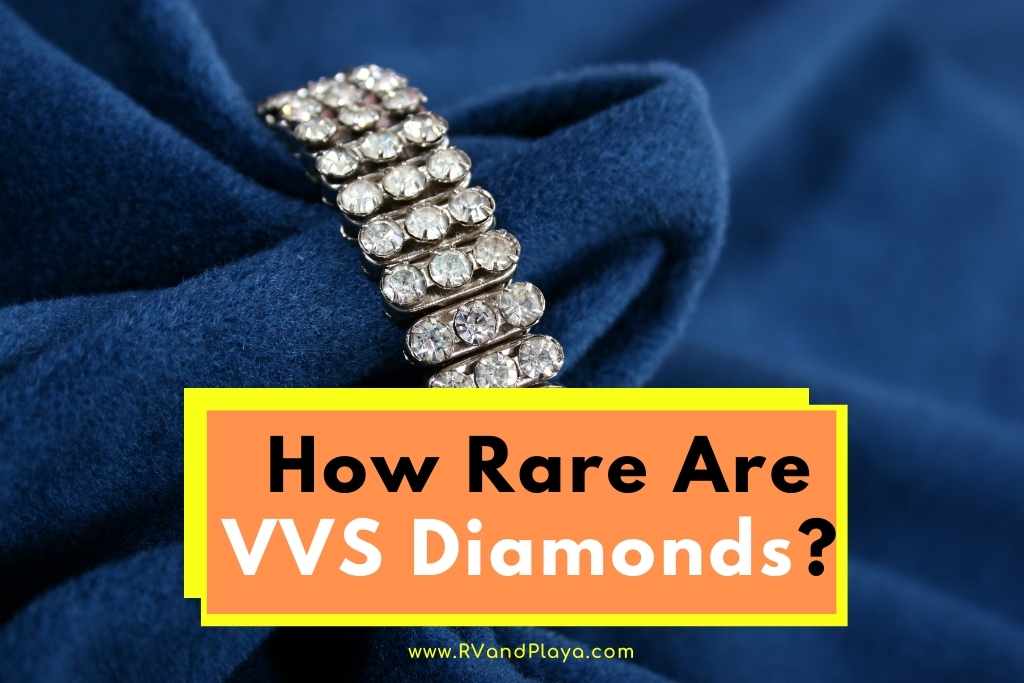When it comes to shopping for diamonds, there are a number of factors that influence the cost, Clarity grading among them. Clarity can range from F (Flawless) to I3 (Heavily and Visibly Included). with several values in-between.
VVS is a clarity value that stands for Very Very Slightly Included and can be rated VVS1 or VVS2. These stones are some of the highest quality, next to Flawless, and represent about 5% of all commercially sold diamonds.
For more information on VVS diamonds and their rarity, read on.
Table of Contents
How Rare Are VVS Diamonds?
The greater the Clarity, the rarer the stone is.
VVS stones are reputed to make up only 1% to 5% of diamonds on the market.
There are some sources that claim the percentage is as high as 7% of diamonds, however, the exact percentage depends on whether you include stones that are not sold for jewelry, and what level of inclusions you include in the VVS category.
How Does The Rarity Compare to Other Classifications of Diamonds?
VVS diamonds are more common than Flawless or Internally Flawless diamonds.
On the other hand, they are far less common VS, SI, and I graded diamonds.
For a more precise comparison, Jewelry-Secrets claims the following numbers:
- Flawless or Internally Flawless: 2%
- VVS: 7%
- VS: 14%
- SI: 25%
- I: 52%
Why Are VVS Diamonds So Rare?
The greater the clarity, the greater rarity. VVS Diamonds – separated into VVS1 and VVS2 sub categories – are the third and fourth levels of clarity.
This means they have far fewer and less visible flaws than a diamond listed with a VS, SI or I level clarity.
Diamonds are formed under immense heat and pressure, which makes it easy for them to develop flaws. Likewise, it’s not impossible for a diamond to retain dark flecks of the original carbon color.
Truly flawless and nearly flawless stones are difficult to find, even once the diamonds have been cut and polished.
- Save an Average of $350* on Lab-Created Diamonds
- James Allen is the leader in online diamond sales
What Exactly Are VVS Diamonds?
VVS is a classification of diamonds involving a specific category or grading.
Diamond Grading involves 4 characteristics: Carat Weight, Color, Cut, and Clarity.
VVS is a grading used to describe Clarity. VVS stands for Very, Very Slightly Included.
What Are the Different Classifications of Diamonds?
Diamonds are classified according to 4 categories: Cut, Clarity, Color, and Carat Weight.
Clarity and Color are graded according to a scale:
– Color ranges from D to Z, with D being colorless and Z being heavily tinted.
– Clarity ranges from Flawless to I3.
VVS is part of the Clarity Scale, which is as follows:
- Flawless
- Internally Flawless
- Very, Very Slightly Included (VVS1 and VVS2)
- Very Slightly Included (VS1 and VS2)
- Slightly Included (SI1 and SI2)
- Included (I1, I2, I3)
Read also >> Are VVS Diamonds Lab Created? (Real Diamonds + More)
Read also >> VVS Diamonds Chain Price (All You Need To Know)
How Do I Differentiate a VVS Diamond From a Different Grade of Diamond?
The only way to differentiate between a VVS stone and a different grade is by the use of a microscope at a minimum 10x magnification. Often, for VVS diamonds, a higher magnification is required.
VVS diamonds have very small inclusions, usually only pinpricks. A high magnification is required to spot these inclusions to separate a Flawless diamond from a VVS diamond.
How Do I Differentiate a Flawless Stone From a VVS1 or a VVS2?
The difference between the three – or four – grades of diamond clarity can only be seen with a high-powered microscope. Professionally, the differences are described in the following manner:
– Flawless:
Stone has no imperfections, internally or externally, not even at top magnifications.
– Internally Flawless:
Stone has no imperfections internally but might have very slight imperfections on the surface, such as cracks or small chips.
An Internally Flawless stone might be damaged by the cutting and faceting process, or have flaws revealed by the process.
– VVS1 (Very Very Slightly Included 1):
These flaws are very small, usually just pinpricks.
Sometimes they are microscopic cracks or bubbles. Other inclusions may involve flecks of carbon invisible to the naked eye.
VVS1 stones are also likely to have inclusions in locations that are hard to spot without close inspection.
Locations include the girdle, the base of the diamond, or areas that would be hidden by a setting for jewelry.
– VVS2 (Very Very Slightly Included 2):
These flaws are still microscopic pinpricks, invisible to the naked eye, or lower settings of magnification.
VVS2 stones are likely to have more inclusions than VVS1 counterparts.
VVS2 stones usually have stones in more visible locations, such as the top of the diamond.
What Is The Difference Between VVS Diamonds and Lower Grades?
VS, SI and I grades of clarity have inclusions that are visible under lower magnifications or even the naked eye.
– VS stones are often eye-clean (unflawed to the naked eye), but even low magnifications are capable of seeing the inclusions that are present.
– SI stones are sometimes eye-clean, sometimes with small but visible inclusions
– I stones have visible inclusions, with Grade 1 being the fewest and smallest and Grade 3 being highly included.
Stones with a grade lower than I3 are not sold on the gemstone or jewelry market.
Read also >> Are VVS Diamonds Expensive? (All You Need To Know)
Read also >> How Much Is a 1 Carat Uncut Diamond Worth?
What Is the Relative Value of a VVS Diamond Compared to Other Grades of Diamonds?
A higher grade of Clarity is generally synonymous with a higher price. However, color and size also play a part in the final determination.
The table below shows some examples of the relative price range for 1.00 carat diamonds of varying grades:
| Cut | Clarity | Color | Price | |
|---|---|---|---|---|
| Round – Excellent | VVS1 | D | James Allen | $11,020 |
| Round – Excellent | S1 | H | James Allen | $4,190 |
| Round – Excellent | VS1 | H | James Allen | $6,990 |
| Round – Very Good | VVS1 | G | Rare Carat | $2,027 |
| Round – Excellent | VS1 | G | Rare Carat | $1,754 |
| Emerald | VVS2 | H | James Allen | $4,210 |
* Prices vary by anywhere from a few hundred dollars to a few thousand when it comes to varying grades and cuts.
* Price variance is often determined by the individual jeweler.
If all stones are of equal size and Clarity Grade, the price range may look something like the table below.
The following table shows prices for various Cuts, Colors, and Sizes of VVS Diamonds:
| Cut | Size | Color | Price | |
|---|---|---|---|---|
| Round – Excellent | 1.00 | D | James Allen | $11,020 |
| Princess – Excellent | 2.01 | H | Rare Carat | $20,053 |
| Round – Ideal | 1.21 | I | Blue Nile | $10,493 |
| Radiant – Super Ideal | 1.00 | F | Brilliance | $5,498 |
| Asscher | 1.00 | D | Adiamor | $8,536 |
* Prices are influenced partially by individual retailers as well as size, cut, and color.
How Much Does VVS Quality Grading Affect The Price of A Stone?
The truth is that there are numerous factors that influence the final price of a stone. Aside from Clarity, every diamond is judged by:
- Size
- Cut Type
- Cut Precision and Skill
- Color
- Natural or Lab Grown
- Certified or Not
And this is in addition to individual pricing standards by various retailers. So figuring out how different factors affect pricing can be a tricky task.
However, as can be seen in the first table:
– There is a ~$250 price difference between similar stones of different clarity offered by Rare Carat.
– There is a ~$4,000 price difference between similar stones of differing clarity offered by James Allen
This can give you an idea of how the difference between VVS Clarity and other levels of clarity can change the prices.
What Else Should I Know About The Rarity and Value of VVS Diamonds?
– VVS Diamonds can maintain their value to a high level, given their almost flawless quality.
– VVS Diamonds can command a high price due to high quality and a high degree of rarity.
– If you’re shopping on a budget, VVS diamonds are not the best option.
– In terms of appearance to the naked eye, VVS and VS diamonds are fairly similar, but VS diamonds are more affordable.
– You can’t see imperfections in a VVS without a high magnification, so if you can see inclusions with less than 30x, then you may have a fake or mislabeled VVS gem.
James Allen is the leader in online diamond sales. Their imaging technology is the same as inspecting a diamond with a jeweler's loupe. They have the largest exclusive loose diamond inventory online and fantastic prices.
They also have the nicest collection of lab created diamonds online. Save 10% off select lab grown diamonds and 25% off ring settings during limited time sale!
WHAT WE LOVE ABOUT THEM:
- No questions asked returns within 30 days of shipment. James Allen will send you a paid shipping label to return the ring.
- Lifetime Warranty
- Free International Shipping
- Free prong tightening, repolishing, rhodium plating and cleaning every 6 months
- Provide insurance appraisals
- One free resizing within 60 days of purchase
- Free ring inscriptions
- Best-in-class high quality imagery of all diamonds in stock
- 24/7 Customer Service
- Best-in-class packaging
Final Thoughts
Diamonds that qualify for VVS status are rare – only approximately 7% of all diamonds sold in the gemstone trade are given this designation.
While not as rare as Flawless stones, they’re still rare enough to command a correspondingly high price tag.
If you’re looking for something rare and stunning, a VVS diamond will fit the bill. But if affordability is an issue, the rarity of VVS stones means you might want to look at a VS stone as an option – they offer most of the brilliance and only part of the cost.
References
https://www.gemsociety.org/article/vvs-diamond-guide/
Recent Posts
Lindsey, do you know if VVS diamonds are real or fake? This is one of the questions our readers ask a lot. Well, we´ve got you covered. If you are in the market for a diamond, or even just...
Most of us know there are naturally occurring diamonds and lab created diamonds. Both are beautiful. Both can be set to make exquisite jewelry. But naturally occurring diamonds are typically more...


